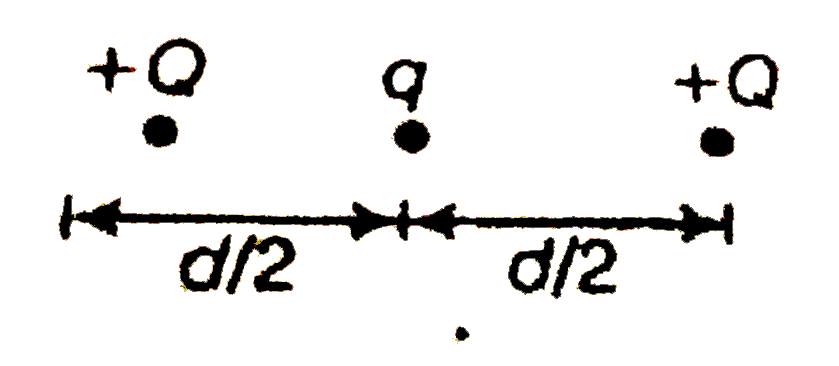Two charged particles each having a charge +q and mass m are kept at a distance d. if they are in equilibrium under the gravitational force and the electric force between them, then the ratio qm or specific charge of each particle is
√4πε0G
√4πε0G
4πε0G
G4πε0
The correct Answer is:B
FE=FG∴14πε0q2d2=Gm2d2∴(qm)=√4πε0G
Topper's Solved these Questions
- BOOK - MARVEL PUBLICATIONCHAPTER - ELECTROSTATICSEXERCISE - TEST YOUR GRASP20videos
ELECTROSTATICS
- BOOK - MARVEL PUBLICATIONCHAPTER - ELECTRONS AND PHOTONS EXERCISE - TEST YOUR GRASP - 1715videos
ELECTRONS AND PHOTONS
- BOOK - MARVEL PUBLICATIONCHAPTER - GRAVITATION EXERCISE - TEST YOUR GRASP -220videos
GRAVITATION
Similar Questions
Two large parallel thin plates having uniform charge densities +σand−σ are kept in X-Z plane at a distance d apart. Sketch an equipotential surface due to electric field between the plates. If a particle of mass m and charge −q remains stationary between the plates, what is the magnitude and direction of the filed ?
View SolutionA particle of mass m and charge +q is located midway between two fixed charged particles each having a charge +q and at a distance 2L apart. Assuming that the middle charge moves along the line joining the fixed charges, calculate the frequency of oscillation when it is displaced slightly.
View Solution
Knowledge Check
- Question 1 - Select One
As shown in the adjoining figure two charge particles each having charge q and mass m and d distance apart from each other. If two particle in equilibrium under the gravitational and electric force, then determine the ratio q/m.
 A10−8B10−10C1010Dnone
A10−8B10−10C1010Dnone - Question 2 - Select One
Two particles , each of mass m and carrying charge Q , are separated by some distance. If they are in equilibrium under mutual gravitational and electrostatic force then Q/m(∈C/kg) is of the order of
A10−5B10−10C10−15D10−20 - Question 3 - Select One or More
A particle of mass m and charge q is thrown in a region where uniform gravitational field and electric field are present. The path of particle:
Astraight lineBellipseCparabolaDcircle
There is a particle A with positive charge q1 and mass m. There is another particle B with negative charge q2 and mass m. Particles A and B are moving along circular paths under electrostatic attraction in such a manner that separation between them is d and location of their centre of mass is centre of circular path. What will be the angular velocity of particles?
View SolutionA particle of mass m and charge q is located midway between two fixed charged particles each having a charge q and at a distance 2L apart so that distance of this charge from each charge located at end is L. Assuming that the middle charge moves along the line joining the fixed charges. The frequency of oscillation when it is displaced slightly is
View SolutionTwo particles having charge Q1 and Q2 , when kept at a certain distance exert a force F on each other . If the distance between the two particles is reduced to half and the charge on each particle is doubled , the force between the particles would be
View SolutionTwo positively charged particles each having charge Q and are d distance apart. A third charge is introduced in midway on the line joining the two charges. Find the nature and magnitude of third charge so that the system is in equilibrium.
 View Solution
View SolutionTwo charges each of 1μC are at 3 cm. Then the force between them is
View Solution

